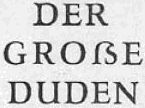Duden


The Duden (German pronunciation: [ˈduːdən]) is a dictionary of the German language, first published by Konrad Duden in 1880. The Duden is updated regularly with new editions appearing every four or five years. As of August 2013 it is in its 26th edition it is printed as 12 volumes with each volume covering different aspects of the German language such as loanwords, etymology, pronunciation, synonyms, etc.
The first of these volumes, Die deutsche Rechtschreibung (English: German Orthography), has long been the prescriptive source for German language spelling. The Duden has become the predominant language resource of the German language, stating the definitive set of rules regarding grammar, spelling and use of German language.[1]
History
Konrad Duden
In 1872, Konrad Duden, headmaster of a Gymnasium (secondary school) in Schleiz, now in Thuringia, published a German dictionary called the Schleizer Duden, the first Duden. In 1880 he published the Vollständiges Orthographisches Wörterbuch der deutschen Sprache (Complete Orthographical Dictionary of the German Language); this seminal treatise was declared the official source for correct spelling in the administration of Prussia the same year. The first edition of the Duden contained 28,000 entries.
From 1901 to 1996
In 1902 the Bundesrat confirmed the Duden as the official standard for German spelling; Austria-Hungary and Switzerland soon followed suit.
In the ensuing decades, the Duden continued to be the de facto standard for German orthography. After World War II this tradition continued separately in East and West Germany in Leipzig and Mannheim, respectively.
In West Germany, some publishing houses began to attack the Duden "monopoly" in the 1950s, publishing dictionaries which contained alternative spellings. In reaction, in November 1955 the ministers of culture of the states of Germany confirmed the spellings given by the Duden would continue to be the official standard.
East German Duden (Leipzig)

In 1954, the first published Duden appeared in Mannheim, the western counterpart to the traditional Duden printing city of Leipzig. The first East German Duden appeared in Leipzig in 1951 but was largely ignored as illegitimate by West Germany. The printing continued in both Mannheim and Leipzig until the fall of the Berlin Wall in 1989. The differences between the two versions of Duden printed during this period appear in the number of entries (Stichwörter). As the printing of the two Dudens began, in 1954 and 1951, the number of Stichwörter included was roughly the same. As the split between the printers versions continued, the East German Duden slowly began diminishing the number of Stichwörter in its volume while the West German Duden printed in Mannheim increased the number of Stichwörter. The major differences between the two Dudens are seen in the lexical entries. The East German Duden included various loan words from Russian, particularly in the area of politics, such as Politbüro and Sozialdemokratismus. Also new to the East German Duden were words stemming from Soviet agricultural and industrial organization and practices.
Of note, there are few semantic changes recorded in the East German Duden that evolved from contact with Russian language. The East German Duden records the nominalization of German words by adding the suffix -ist, borrowed from the Russian language suffix. Furthermore, additional words were recorded due to increasing the number of adverbs and adjectives negated with the prefix un-, such as unernst ("un-serious") and unkonkret ("un-concrete", "irreal"). The few lexical and semantic items recorded in the East German Duden migrated from der große Duden because the printing press in Leipzig did not publish the multiple volume Duden which has become the current standard.
Reform Duden
On the cover of the Duden, 25th Edition, Volume 1, these words are printed in red letters: Das umfassende Standardwerk auf der Grundlage der aktuellen amtlichen Regeln. This translates as: "The comprehensive standard reference based on the current official rules."
The "current official rules" are the outcome of the German orthography reform of 1996.
Volumes
- Die deutsche Rechtschreibung – The Spelling Dictionary
- Das Stilwörterbuch – The Dictionary of Style
- Das Bildwörterbuch – The Pictorial Dictionary
- Die Grammatik – The Grammar
- Das Fremdwörterbuch – The Dictionary of Foreign Words
- Das Aussprachewörterbuch – The Pronouncing Dictionary
- Das Herkunftswörterbuch – The Etymological Dictionary
- Das Synonymwörterbuch – The Thesaurus
- Richtiges und gutes Deutsch – Correct and Good German (Guide to usage)
- Das Bedeutungswörterbuch – The Dictionary (Definitions)
- Redewendungen – Figures of Speech
- Zitate und Aussprüche – Quotations and Sayings
Literature
- Betz, Werner. Verändert Sprache die Welt: Semantik, Politik und Manipulation [Modified language of the world: semantics, politics and manipulation]. Edition Interfrom AG: Zürich, 1977.
- Hellmann, Manfred W. (ed.) Zum Öffentlichen Sprachgebrauch in Bundesrepublik Deutschland und in der DDR [On public usage in the Federal Republic of Germany and in the GDR]. Düsseldorf: Pädagogischer Verlag Schwann, 1973.
- Reich, Hans H. Sprache und Politik: Untersuchungen zu Wortschatz und Wortwahl des offiziellen Sprachgebrauchs in der DDR [Language and politics: studies on vocabulary and terminology of the official use of language in the GDR]. Munich: Max Hueber Verlag, 1968.
- Schlosser, Horst Dieter (ed). Kommunikationsbedingungen und Alltagssprache in der ehemaligen DDR [Communications requirements and everyday language in the former GDR]. Hamburg: Helmut Buske Verlag, 1991.
- Siegl, Elke Annalene. Duden-Ost, Duden-West: Zur Sprache in Deutschland seit 1945: ein Vergleich der Leipziger und der Mannheimer Dudenauflagen seit 1947 [Duden East, Duden West: On language in Germany since 1945: a comparison of Leipzig and Mannheim editions of Duden since 1947]. Düsseldorf: Schwann, 1989.
References
- ↑ Gerhard Weiss (1995). "Up-to-Date and with a Past: The "Duden" and Its History". Die Unterrichtspraxis / Teaching German. Wiley. 6 (1: The Publisher as Teacher): 7–21. doi:10.2307/3531328. JSTOR 3531328.
External links
| Wikimedia Commons has media related to Duden. |
- Official website (German)